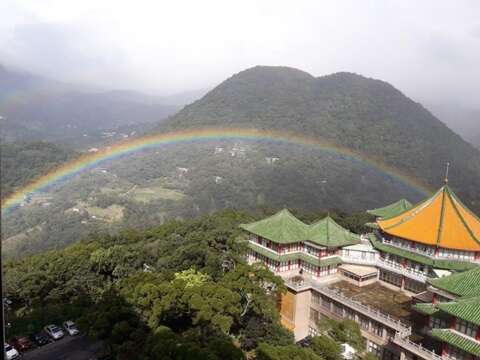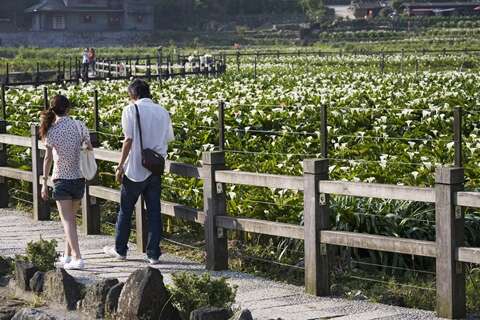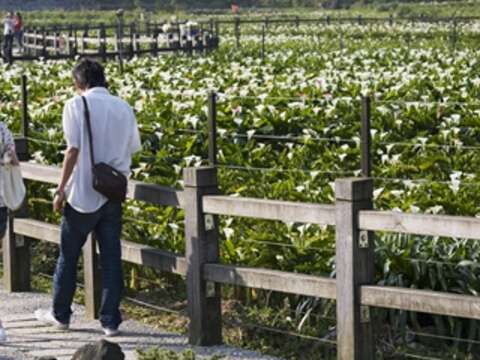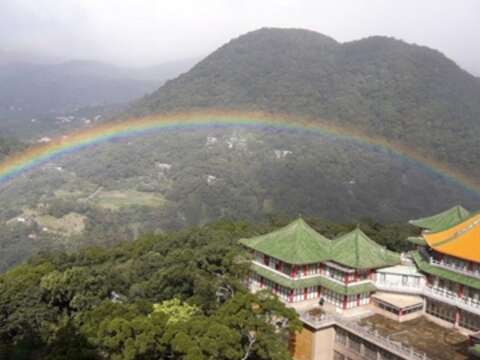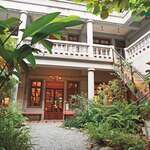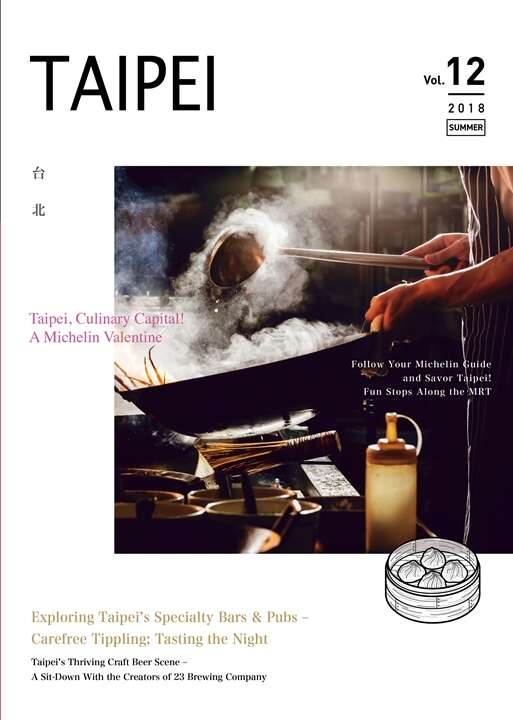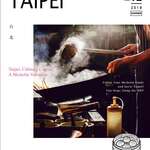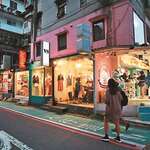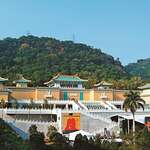Post date:2018-06-13
1274
A “Follow the Rainbow” Tour
Article Chung Wen-Ping
Photos Professor Chou Kun-hsuan, Chinese Culture University; Chic-Jen Yan
▲The world’s longest-lasting rainbow, recognized by a Guinness World Record, rises in the mountains of CCU. (Photo: Professor Chou Kun-hsuan, CCU)
If you happened to be in Taipei on November 30th last year, and you happened to look up into the sky on that long autumn day, you, along with the whole wide world, would have witnessed the breaking of a world record by Chinese Culture University (文化大學; CCU), located on Yangmingshan (陽明山). The “Long-lived Rainbow” appeared on the university’s northwest side at 6:37am, first descending to the north into a mountain valley, then rising into the northeastern sky. This magical rainbow bridge seemed to remain fixed in place throughout the day, “hanging” in the sky for nine hours before evaporating at 3:55pm. This surpassed the previous record of six hours set at Wetherby in Yorkshire, England on March 14th, 1994; and it was the first time that Taiwan had ever garnered an official Guinness World’s Record related to natural phenomena. The feat generated both amazement and great buzz, riveting the country’s attention and drawing foreign media coverage as a genuine hot topic.
For Panoramas Overlooking Taipei – Call CCU No. 1!
Spotting a rainbow and enjoying it is a matter of luck, not choice. However, you can still choose to follow the path of the Long-lived Rainbow, by climbing Taipei’s mountains on a mini-trip with all the romance of a rainbow and the “spur of the moment” feeling of lucky fortune.
The Long-lived Rainbow’s birthplace, CCU, is located in the Datun Mountain Range (大屯山系) at an elevation of 460 meters, making it Taipei’s “highest” institute of higher learning. It is also one of the few universities in Taiwan located near a national park. Each time the mountain rains depart and the sun reappears, rainbows will almost imperceptibly appear around the campus. Among CCU folk, the nickname for their school is the “Home of Rainbows,” a moniker that is in no way undeserved!
With its lofty perch, CCU also enjoys a panoramic vista over Taipei City, and is a superb location for sunset and nightscape viewing. The prime spot, behind the gymnasium, is known as “Rear Mountain Lovers’ Slope” (後山情人坡). As one walks along Xia Dongshi Industrial Road (下東勢產業道路) from Tianmu East Road (天母東路), the terrain becomes elevated and no obstacle blocks lines of sight. If it’s free of fog and heavy rain, the Tamsui River (淡水河), Mt. Guanyin (觀音山), and the mass of humanity between mountain and river – the flow of traffic and the great cluster of buildings – can be taken in at a glance. Taipei spreads out like a super-sized map at your feet, everything clearly laid out and caught in a single sweep of your eye, a superb tableau that is unmatched!
▲Zhuzihu’s calla lily fields have the pretty look of scattered snow on high mountains. (Photo: Chic-Jen Yan)
The Romance of American Military Housing
CCU’s neighborhood, Shanzihou (山仔后), is also home to a large concentration of old bungalows built in the 1950s as American military housing. The Korean War had erupted, and the US was attempting to prevent Communist expansion in Asia. A Military Assistance Advisory Group (MAAG) was dispatched to Taiwan, and military housing built for US officers stationed here. A meticulous search for possible locations was conducted, with US advisors and architects even taking to the skies in helicopters to inspect the city from above – Taipei map in hand! Once this quiet and secluded high-mountain area was selected, 217 bungalows were constructed in the style of American country homes. Each is on a plot at least 264 square meters in size, surrounded by lawn with a patio, and each has a fireplace inside. Another feature rarely seen in Taiwan are the chimneys, which create a distinctive “little American village” look. Other residents of the area dubbed it “foreigner housing,” or a dou a cuo. Today, this is the most intact American military housing enclave left in Taiwan.
After the US military departed Taiwan, the homes were left abandoned for a considerable period. In recent times, the Taipei City Government has taken the lead in an energetic renovation and rejuvenation initiative that has given birth to an American-style café and a dessert shop in two of the buildings. This has enabled this Taipei enclave, which experienced its modern Western cultural baptism long ago, to renew its connection with the daily lives of Taipei’s citizenry. Maple trees swish daintily along the lanes, while clouds and mists creep up the mountainside. The quaint retro beauty of the scene seems right out of an old movie. This is a grand spot for relaxed scenery viewing, while you sip on a coffee and eat sweets, whiling away a sumptuously decadent and lazy afternoon.
Cherry Blossoms and Calla Lilies Blooming in Relay
Just as the Japanese enjoy viewing their cherry blossoms, so, the people of Taipei make an annual pilgrimage up Yangmingshan to take in the flowers. This city’s residents are just a little more fortunate, however, in that the Yangmingshan flower season lasts more than half the year! The show begins in early spring with the Taiwan cherry and Showa cherry blossoms; then the Chinese hydrangea, Yoshino cherry, azalea, calla lily, and big-leaf hydrangea bloom in turn. These stunning landscapes are ephemeral, each lasting only a short time throughout the spring and summer. Miss out and you can only wait patiently for next year.
Yangmingshan’s flower-appreciation sites include the Flower Clock (花鐘), Floriculture Experiment Center (花卉試驗中心), Yangmingshan National Park Visitor Center (陽明山國家公園遊客中心), and other locations. Augmenting the list (each February/March) is the splendid Cherry Blossom Tunnel on Fuxing 3rd Road (復興三路) and the newly-planted Yoshino cherry trees outside Fuxing Senior High School (復興高級中學). Unlike the sparsely-flowering roadside cherry trees, commonly arranged in twos and threes, the Formosan cherry trees along Fuxing 3rd Road and outside Baigong Shanzhuang (白宮山莊) were planted long ago by the Beitou District Office (北投區公所), resulting in a concentrated “sea of flowers” along both sides of the road. When the wind blows, the splendid colors of the falling blossoms in every way rivals that of the famed “wind-blown snow” in Japan.
In the past, there was a grand old tree stood behind the rear entrance at Fuxing Senior High School. Aged around sixty years, it was dubbed the “Cherry King” because of its tremendous blossoms. Sadly, in 2015 it breathed its last; brown root rot necessitating its removal. Since then the school has planted new Yoshino cherry trees along the sidewalk on the left side, and the rich tapestry of the ebullient blooming has both surprised and delighted viewers. Expectations are that this annual natural event will become a popular tourist draw someday.
In April, the cherry blossoms fade into memory and the calla lilies obligingly burst onto the scene. The calla lilies of Zhuzihu (竹子湖) are perennials with flowering bulbs from the family Araceae. April is their peak production period, with 12 hectares under cultivation; and white and green wetland calla lilies form the majority. Zhuzihu accounts for over 80% of Taiwan’s calla lily output. Springtime is the loveliest time of year in Zhuzihu, with a large swath of the intersecting green fields thickly speckled with white flowers like a beautiful high-mountain snowfall. The biggest difference between calla lilies and other types of flowers on Yangmingshan is that you can appreciate them from afar and also legally pick them. Rent your waterproof boots and gear from the farmer and head out into the fields to experience the fun of picking flowers yourself! The calla lily’s lovely large, snow-white spathe and green stem form a simple, elegant line. Choose carefully, measuring them one after another, and pluck only those lilies that have won your heart. If that isn’t “romance,” what in the world is!?
Gallery
Popular articles
 TAIPEI QUARTERLY 2018 SUMMER Vol.12
TAIPEI QUARTERLY 2018 SUMMER Vol.12 Follow Your Michelin Guide and Savor Taipei! Fun Stops Along the MRT (TAIPEI QUARTERLY 2018 SUMMER Vol.12)
Follow Your Michelin Guide and Savor Taipei! Fun Stops Along the MRT (TAIPEI QUARTERLY 2018 SUMMER Vol.12) East Town The Trendy Fashion Route (TAIPEI QUARTERLY 2018 SUMMER Vol.12)
East Town The Trendy Fashion Route (TAIPEI QUARTERLY 2018 SUMMER Vol.12) West Town The Glorious Traditional Route (TAIPEI QUARTERLY 2018 SUMMER Vol.12)
West Town The Glorious Traditional Route (TAIPEI QUARTERLY 2018 SUMMER Vol.12) Zhongzheng District The Art Enthusiast's Route (TAIPEI QUARTERLY 2018 SUMMER Vol.12)
Zhongzheng District The Art Enthusiast's Route (TAIPEI QUARTERLY 2018 SUMMER Vol.12) Shilin District The Intellectual LOHAS Route (TAIPEI QUARTERLY 2018 SUMMER Vol.12)
Shilin District The Intellectual LOHAS Route (TAIPEI QUARTERLY 2018 SUMMER Vol.12)
 A “Follow the Rainbow” Tour (TAIPEI QUARTERLY 2018 SUMMER Vol.12)
A “Follow the Rainbow” Tour (TAIPEI QUARTERLY 2018 SUMMER Vol.12)